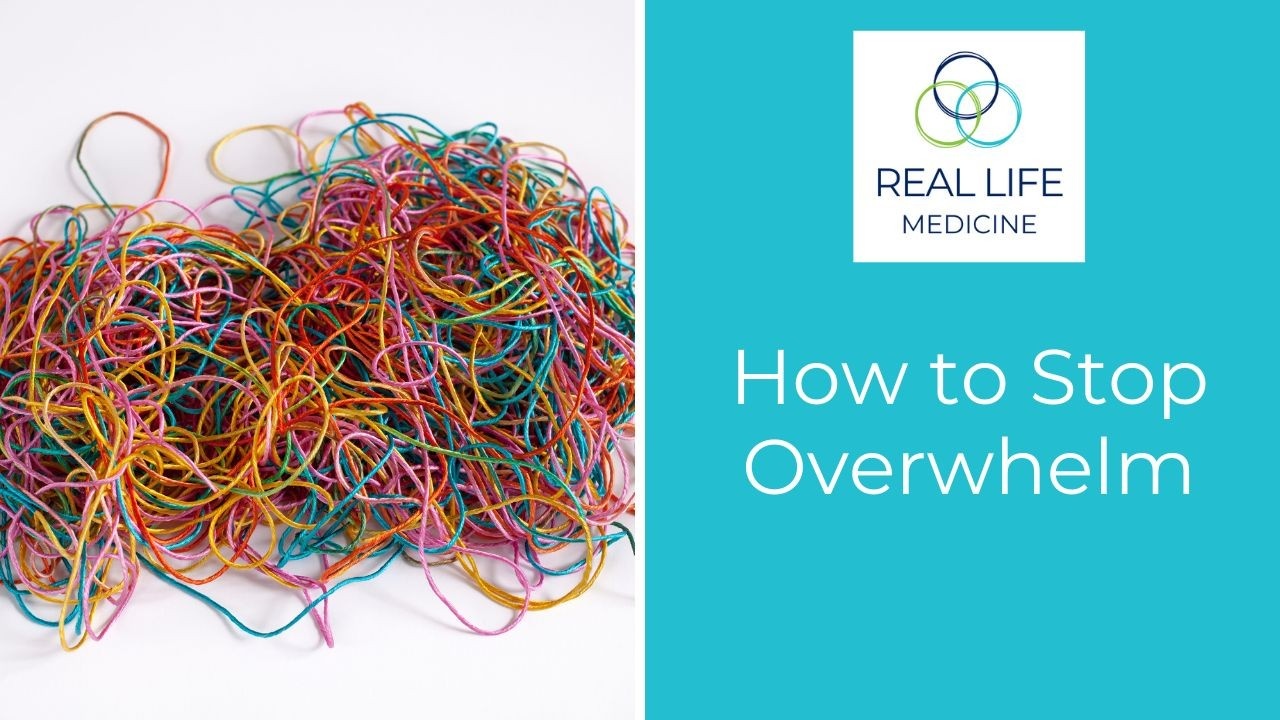
How to Stop Overwhelm
Jul 20, 2022“I just feel so overwhelmed”
This would be one of the most common things people say to us as doctors.
Feeling Overwhelmed is one of the major reasons people don't continue on with their health journey.
They stop doing the things because they feel too overwhelmed
The phrase that is often used is “I have too much on my plate”
And we get it. Our busy lives are busy.
There are always jobs to do, places to go, things to deliver, appointments to attend, shopping to be done, pets to walk, food to cook, deadlines for work,
The dictionary definition of overwhelm is straightforward but not helpful
“ too much to deal with”
Overwhelm is feeling like you have all the balls in the air and you are either dropping the balls or at risk of dropping them. It feels like this giant ball of tangled up wool. So huge and you can’t find the start.
When we don't know where to start, we can’t start-sounds obvious right?
And so we don't start.
We will avoid it by doing something else and with the availability of a million distraction devices on our phones, we will be scrolling on Facebook or Instagram, playing games on phone, watching YouTube videos or vacillating between jobs and not actually getting anything done.
Or more subtle avoidance techniques, and I say subtle because they are tinged with some feelings of virtue, we will clean, fold laundry, make the bed-not of which are a problem except if you are doing them to avoid tackling the problem that is causing you the overwhelm.
Going back to using the “Thought Model”, we know that our thoughts create our feelings and our feelings create our actions
So in the case of overwhelm the story goes a bit like this
Thought- I've got so much to do. I don't know where to start. I’m out of control
Feeling- Overwhelm
Action- Inaction, freezing avoidance, procrastination -cue the FB scrolling etc
And the problem becomes a never-ending cycle with every single little job or task being added to the giant ball of tangled up wool.
The thing that cures our overwhelm is action.
The thing that overwhelms causes is inaction.
You can see the dilemma
So there are 2 issues that we need to address
One is to treat the current overwhelm and the second is to prevent future overwhelm
The issue with overwhelm is that you don't know where to start.
You can’t find the start of the giant ball of wall
So what do we manage to overwhelm?
Follow this 3 step process
Step One Awareness
You will have particular thoughts that go on repeat. You will know these stories
You will also have sensations in your body. This is why emotions are called feelings-you feel them in your body. Tune in to your body sensations. You may feel in your chest, your abdomen, or your jaw. Notice everything about your body
Step Two Write everything down
I know this sounds obvious but this is how to find the start of the ball of wool. When all the thoughts are stuck in our head, they are tangled. We can’t prioritise our tasks because they are all screaming for our attention when they are all tangled.
This is a mind dump
Literally, take a piece of paper and write down everything that is in your brain that requires you to do something. This may be several pages long.
Bear in mind the stories in your brain that may stop you from doing this.
A common one is “I haven't got time to do this” “I don't want to -my list will be too big”
But writing everything down is the most critical step to take you from overwhelmed to in control
Step Three Curate the List
So what I mean is this is where we prioritise our tasks and ditch ones that we don't need to do. When the tasks are in our head then everything feels urgent.
Divide the List
Highlight the tasks that only you can do.
This is important. There will be tasks that there is no way to delegate. And I mean literally, no one can do them except you. Eg going to work, breastfeeding, if you are the only adult- it might be cooking the dinner. (although that could be outsourced)
Then rewrite this list with the tasks only you can do and put the time-critical things at the top. Put a date next when they need to be done by and how long the task will take you. Then allocate time and date to do them
Next, go back to the original list and look at all the tasks that need to be done but not necessarily you.
Ask yourself these questions ad place a number next to each item
- Can I outsource this task? Get a cleaner, a dog walker, a lawn mower, children to fold washing, feed pets etc
- Does this task actually need doing now? Pack swimming bag can be done next week. Clothes need washing now so we have school uniforms tomorrow
- Is doing this task now, going to save me time in the future? Doing online grocery shopping now saves future me stress and saves me time driving to the supermarket
- Can I ditch this task? What happens if this task doesn't get done. Often nothing. If there is no consequence to not doing this task (eg making the bed) then put it on the ditch list.
‘
So now you have a list that can be divided into outsource, do now, do later and ditch.
And now we can find the start of the big ball of wool and take action.
We know that action reduces overwhelm
Repeated action brings momentum and really, momentum is stringing moments of action together
You can download the free workbook here
Next week we talk about preventing overwhelm

